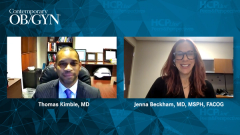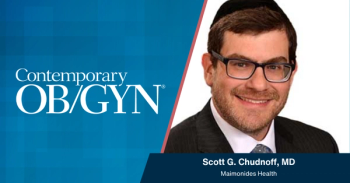
Additional Methods of Contraception
Experts in gynecology review other contraception methods, including the contraceptive ring and drospirenone and estetrol tablets.
Episodes in this series

Jenna Beckham, MD, MSPH, FACOG: There's the new version of the contraceptive ring that you can use for up to a year. What do you think about that?
Thomas Kimble, MD: The segesterone ethinyl estradiol vaginal ring was initially developed by the Population Council and that's exciting. It's the first new transvaginal ring that's been available and it's good for every year. Patients still remove it for a week every month so they still have planned scheduled periods just like they would with the initial atomic estriol ethinyl estradiol vaginal ring. That is not different. What is different though is the initial ring you used it for the 3 weeks and then you threw it away. This ring, it comes with a little retainer case and so you use the ring and then you place it in the case for the 7 days for the week. That's when most people will have a withdrawal period and then after 7 days out you take the same ring, you replace it, and you can use it for the next month. You can continue doing that for a total of 12 cycles or 13 cycles so it's great. You don't have to go back and forth to the pharmacy. For some people it's more cost effective as well.
Jenna Beckham, MD, MSPH, FACOG: Like you said it's nice to not have to worry about picking up a refill, going back to the pharmacy and also, it's maybe a little bit more earth friendly that we're not throwing things away every month.
Thomas Kimble, MD: Exactly.
Jenna Beckham, MD, MSPH, FACOG: Now there's the newer combination pill that has a different formulation of estrogen.
Thomas Kimble, MD: Estetrol.
Jenna Beckham, MD, MSPH, FACOG: Estetrol, the drospirenone and estetrol tablets; that's a really fascinating new formulation and probably appeals to maybe your history buff interests.
Thomas Kimble, MD: It's fascinating as well. We talked about all the benefits of drospirenone and it is having a longer half-life so just to go back to that; the mini pills' half-life is 9 hours, the half-life of the drospirenone is 30 hours, huge difference.
Jenna Beckham, MD, MSPH, FACOG: So much different.
Thomas Kimble, MD: Estetrol has a much longer half-life than ethinyl estradiol one. It is a natural or a native estrogen so there are 4 native estrogens. I'm going to take everybody back to that second-year physiology class, right? I love asking my medical students and residents this question; what are the 4 native estrogens? You have estrone, that is the one that we kind of think of more so with menopause. You have estradiol, that's the main estrogen that we refer to when we talk about the natural estrogen. That's what the ovary produces. You have estriol which is produced by the placenta in pregnancy and then you have estetrol. It all has to do with the number of books, carboxy groups and that's where you get the medroxy groups, that's where you get the estrone, estradiol 2 groups, estriol 3 groups and estetrol 4. It is very interesting. It is produced by the fetal liver and only in higher order primates. That is the only place we see this in nature. We don't know exactly why it exists, what its function is but it's very high in the fetal circulation. When a patient takes estetrol birth control, it is pretty much the same level as in pregnancy, and we think that lends to the safety. One of the great things about estetrol as an estrogen is it is not metabolized by the liver. Other estrogens are metabolized by the liver, so they activate the liver, and that's where you get the other issues that come in. That is where you get the clotting factors.
Jenna Beckham, MD, MSPH, FACOG: Clotting.
Thomas Kimble, MD: That's where you get the lipid and the triglyceride production and some of the other concerns. that's also where you get stimulation of breast tissue. Well, estetrol is not metabolized by the liver. It is metabolized within cells, so that makes it a little different. But it's also what we call a NEST, a Native Estrogen with action in Selective Tissues, and that's interesting because it does not bind to estrogen receptors on cells. And that's where you have the issues with breast stimulation, which makes it a risk factor for breast cancer.
Jenna Beckham, MD, MSPH, FACOG: Breast cancer.
Thomas Kimble, MD: Well, with estetrol, it binds to nuclear receptors, it's a whole entirely different mechanism on how it works, and you don't have some of those concerns. Well, you don't have the bad things. You do have the good things. Tissues that are stimulated by nuclear receptor, which is what estetrol does, would be the endometrium, the uterus, cardiovascular tissues, the vagina, and the brain. Those are things where you want somebody to take estrogen and have the positive effects, and you do get that. It also has a longer half-life; it's about 28 hours. They married it with drospirenone, with the 30-hour half-life I mentioned. Again, this is a pill that also has a lot of forgiveness.
Transcript edited for clarity
Newsletter
Get the latest clinical updates, case studies, and expert commentary in obstetric and gynecologic care. Sign up now to stay informed.








